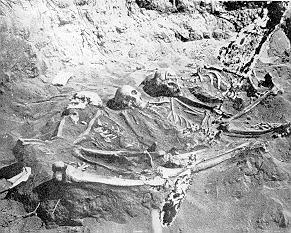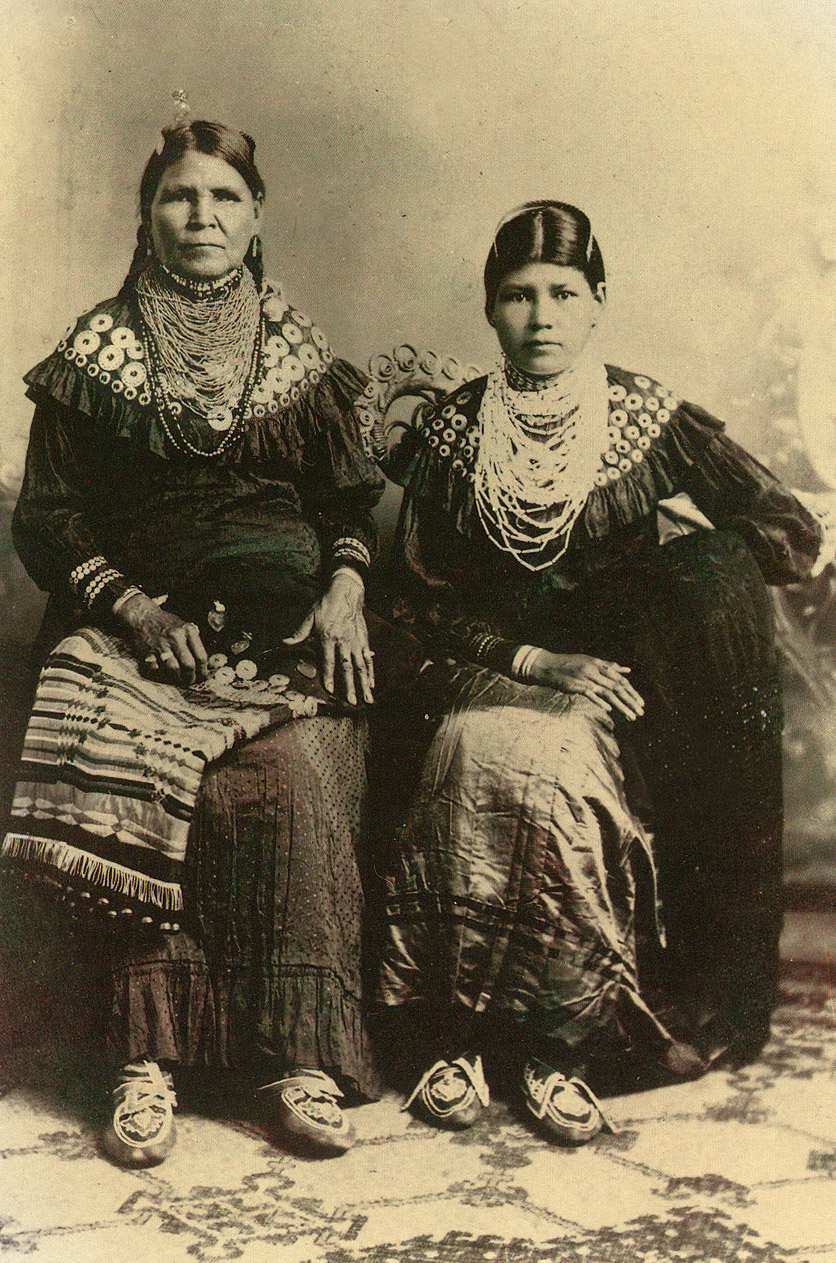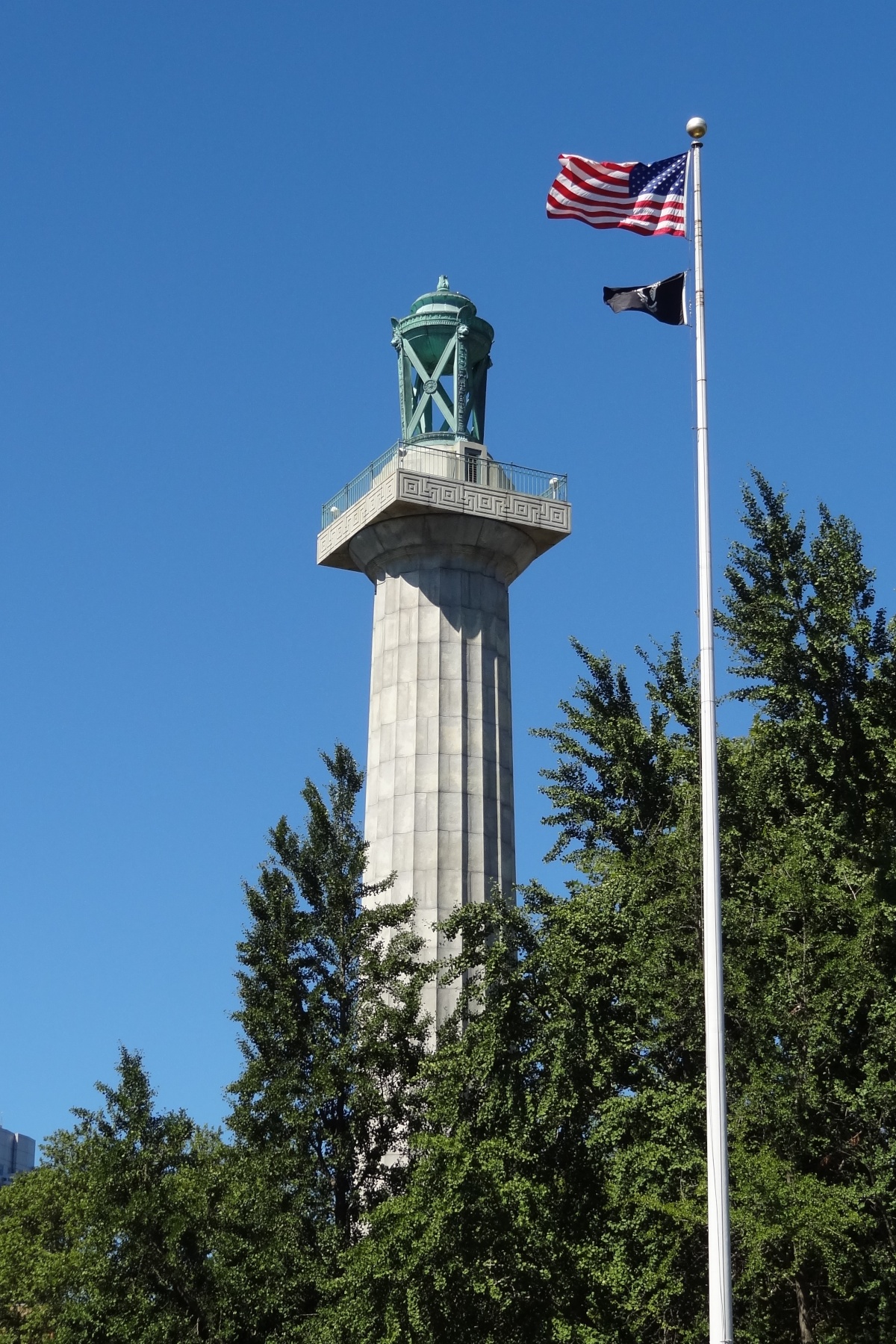|
Staten Island Borough Hall
Staten Island Borough Hall is the primary municipal building for the borough of Staten Island in New York City. It is located at 10 Richmond Terrace, next to the Richmond County Courthouse and opposite the St. George Terminal of the Staten Island Ferry. Borough Hall houses the Borough President's office, offices of the Departments of Buildings and Transportation, and other civic offices. The 1906 French Renaissance style brick and limestone building was designed by Carrere and Hastings, following the consolidation of New York City in 1898. John Carrere was a resident of Staten Island and he helped select the dramatic hilltop site of Borough Hall. The interior of the building contains a series of thirteen WPA murals illustrating events in Staten Island history, painted by local artist Frederick Charles Stahr. The building is a New York City Landmark and was listed on the National Register of Historic Places in 1983. Murals Borough Hall was originally designed with thirteen ar ... [...More Info...] [...Related Items...] OR: [Wikipedia] [Google] [Baidu] |
Staten Island, New York
Staten Island ( ) is a borough of New York City, coextensive with Richmond County, in the U.S. state of New York. Located in the city's southwest portion, the borough is separated from New Jersey by the Arthur Kill and the Kill Van Kull and from the rest of New York by New York Bay. With a population of 495,747 in the 2020 Census, Staten Island is the least populated borough but the third largest in land area at . A home to the Lenape indigenous people, the island was settled by Dutch colonists in the 17th century. It was one of the 12 original counties of New York state. Staten Island was consolidated with New York City in 1898. It was formally known as the Borough of Richmond until 1975, when its name was changed to Borough of Staten Island. Staten Island has sometimes been called "the forgotten borough" by inhabitants who feel neglected by the city government. The North Shore—especially the neighborhoods of St. George, Tompkinsville, Clifton, and Stapleton—is the i ... [...More Info...] [...Related Items...] OR: [Wikipedia] [Google] [Baidu] |
Lenape
The Lenape (, , or Lenape , del, Lënapeyok) also called the Leni Lenape, Lenni Lenape and Delaware people, are an indigenous peoples of the Northeastern Woodlands, who live in the United States and Canada. Their historical territory included present-day northeastern Delaware, New Jersey and eastern Pennsylvania along the Delaware River watershed, New York City, western Long Island, and the lower Hudson Valley. Today, Lenape people belong to the Delaware Nation and Delaware Tribe of Indians in Oklahoma; the Stockbridge–Munsee Community in Wisconsin; and the Munsee-Delaware Nation, Moravian of the Thames First Nation, and Delaware of Six Nations in Ontario. The Lenape have a matrilineal clan system and historically were matrilocal. During the last decades of the 18th century, most Lenape were removed from their homeland by expanding European colonies. The divisions and troubles of the American Revolutionary War and United States' independence pushed them farth ... [...More Info...] [...Related Items...] OR: [Wikipedia] [Google] [Baidu] |
Tottenville
Tottenville is a neighborhood on the South Shore of Staten Island, New York City. It is the southernmost settlement in both New York City and New York State. Tottenville is bounded on three sides by water: the south side abuts New York Bight while the west and north sides are bordered by Arthur Kill. Nassau Place, Bethel Avenue and Page Avenue form the neighborhood's eastern border. The settlement was originally named ''Bentley Manor'' by one of its first settlers, Captain Christopher Billop (1638–1726), a member of the Royal Navy, after his own ship. In 1869 it was renamed as Tottenville after John Totten and his prominent local family of that name, some of whom served as Loyalists under Billop during the American Revolutionary War. Tottenville is part of Staten Island Community District 3 and its ZIP Code is 10307 (formerly "Staten Island 7, New York"). Tottenville is patrolled by the 123rd Precinct of the New York City Police Department. Tottenville has been represented ... [...More Info...] [...Related Items...] OR: [Wikipedia] [Google] [Baidu] |
Clifton, Staten Island
Clifton is a neighborhood on the North Shore of Staten Island in New York City, United States. It is an older waterfront neighborhood, facing Upper New York Bay on the east. It is bordered on the north by Stapleton, on the south by Rosebank, on the southwest by Concord, and on the west by Van Duzer Street. History The name "Clifton" for the area dates to 1817, when a town by the name, larger in area than the present neighborhood, was laid out along the waterfront. In its early history, much of the surrounding land was owned by the Vanderbilt family. As a young man, Cornelius Vanderbilt established ferry service from the waterfront to Manhattan at the foot of present Vanderbilt Avenue. Bayley Seton Hospital, north of Vanderbilt Avenue, was formerly the United States Public Health Service Hospital and housed the original headquarters of the National Institutes of Health (now located in Bethesda, Maryland). In the 1840s, the Townsend family built a huge home that had turrets ... [...More Info...] [...Related Items...] OR: [Wikipedia] [Google] [Baidu] |
Hotel Castleton
A hotel is an establishment that provides paid lodging on a short-term basis. Facilities provided inside a hotel room may range from a modest-quality mattress in a small room to large suites with bigger, higher-quality beds, a dresser, a refrigerator and other kitchen facilities, upholstered chairs, a flat screen television, and en-suite bathrooms. Small, lower-priced hotels may offer only the most basic guest services and facilities. Larger, higher-priced hotels may provide additional guest facilities such as a swimming pool, business centre (with computers, printers, and other office equipment), childcare, conference and event facilities, tennis or basketball courts, gymnasium, restaurants, day spa, and social function services. Hotel rooms are usually numbered (or named in some smaller hotels and B&Bs) to allow guests to identify their room. Some boutique, high-end hotels have custom decorated rooms. Some hotels offer meals as part of a room and board arrangement. In Ja ... [...More Info...] [...Related Items...] OR: [Wikipedia] [Google] [Baidu] |
War Of 1812
The War of 1812 (18 June 1812 – 17 February 1815) was fought by the United States of America and its indigenous allies against the United Kingdom and its allies in British North America, with limited participation by Spain in Florida. It began when the United States declared war on 18 June 1812 and, although peace terms were agreed upon in the December 1814 Treaty of Ghent, did not officially end until the peace treaty was ratified by Congress on 17 February 1815. Tensions originated in long-standing differences over territorial expansion in North America and British support for Native American tribes who opposed US colonial settlement in the Northwest Territory. These escalated in 1807 after the Royal Navy began enforcing tighter restrictions on American trade with France and press-ganged men they claimed as British subjects, even those with American citizenship certificates. Opinion in the US was split on how to respond, and although majorities in both the House an ... [...More Info...] [...Related Items...] OR: [Wikipedia] [Google] [Baidu] |
Fort Tompkins (Staten Island)
Fort Tompkins is a fort on Staten Island in New York City, within what is now Fort Wadsworth at the Narrows. Fort Tompkins (and its predecessor of the same name) guarded the landward approaches to other forts in the area from 1808 through circa 1898. The current fort was built 1847-1861, and was operational as a fort until superseded by new defenses circa 1898. It is now part of the Gateway National Recreation Area. It is the last remaining of four forts in New York State named Fort Tompkins. ''Note:'' This includes History Colonial and Revolution The first use of the land for military purposes was as the site of a blockhouse built by Dutch settler David Pieterszen de Vries in 1636 on Signal Hill (now the site of Fort Tompkins), which was burned in an Indian raid of the Peach Tree War in 1655.Roberts, pp. 587-589 The site is said to have been continuously garrisoned since another blockhouse was built in 1663, which survived at least through 1808.Roberts, pp. 587-589 During the A ... [...More Info...] [...Related Items...] OR: [Wikipedia] [Google] [Baidu] |
Battery Weed
Battery Weed is a four-tiered 19th century fortification guarding the Narrows, the main approach from the Atlantic Ocean to New York City. Located on the Staten Island waterfront on the west shore of the Narrows, directly across from Fort Hamilton and the now-destroyed Fort Lafayette in Brooklyn, the fort was intended to protect New York from attack by sea. When built, it was named Fort Richmond, as was a previous fort on the site. History Early 19th century The first fort on the site was built by the State of New York beginning in 1806, which was ready for service in 1808 though incomplete. This fort was built of red sandstone and named Fort Richmond, after the county in which Staten Island is located, which was named for Charles Lennox, 1st Duke of Richmond. It was protected on the landward side by the first Fort Tompkins, also built of red sandstone by the state. Fort Richmond was initially semicircular while Fort Tompkins was a regular pentagon with circular bastions, both ve ... [...More Info...] [...Related Items...] OR: [Wikipedia] [Google] [Baidu] |
Evacuation Day (New York)
Evacuation Day on November 25 marks the day in 1783 when the British Army departed from New York City on Manhattan Island, after the end of the American Revolutionary War. In their wake, General George Washington triumphantly led the Continental Army from his headquarters north of the city across the Harlem River, and south through Manhattan to the Battery at its southern tip. History Background Following the significant losses at the Battle of Long Island on August 27, 1776, General George Washington and the Continental Army retreated across the East River by benefit of both a retreat and holding action by well-trained Maryland Line troops at Gowanus Creek and Canal and a night fog which obscured the barges and boats evacuating troops to Manhattan Island. On September 15, 1776, the British flag replaced the American atop Fort George, where it was to remain until Evacuation Day. Washington's Continentals subsequently withdrew north and west out of the town and follo ... [...More Info...] [...Related Items...] OR: [Wikipedia] [Google] [Baidu] |
Conference House
Conference House (also known as Billop House) is a stone house in Tottenville, Staten Island, New York City built by Captain Christopher Billopp some time before 1680. It is located in Conference House Park near Ward's Point, the southernmost tip of New York State on Staten Island, which became known as "Billop's Point" in the 18th century. The Staten Island Peace Conference, an unsuccessful attempt to find a swift negotiated end to the American Revolutionary War, was hosted by his heir and grandson Colonel Christopher Billop, there on September 11, 1776. The house, a National and New York City Landmark, is located at Conference House Park overlooking Raritan Bay. The house is also located within the Ward's Point Conservation Area, separately added to the National Register of Historic Places in 1982. ''See also:'' Construction Captain Christopher Billopp, after years of distinguished service in the Royal Navy, came to America in 1674. He was granted a land patent on 932 ... [...More Info...] [...Related Items...] OR: [Wikipedia] [Google] [Baidu] |
Edward Rutledge
Edward Rutledge (November 23, 1749 – January 23, 1800) was an American Founding Father and politician who signed the Continental Association and was the youngest signatory of the Declaration of Independence. He later served as the 39th governor of South Carolina. Early life and education Rutledge was born in Charleston, South Carolina. He was the youngest of seven children (5 sons and 2 daughters) born to Dr. John Rutledge and Sarah Hext. His father was a physician and colonist of Scots-Irish descent; his mother was born in South Carolina and was of English descent. Following his brothers John and Hugh he studied law in London at the Inns of Court. In 1772 he was admitted to the English bar (Middle Temple) and returned to Charleston to practice. He was married on March 1, 1774, to Henrietta Middleton (17 November 1750 – 22 April 1792), daughter of Henry Middleton. The couple had three children: * Major Henry Middleton Rutledge (5 April 1775 – 20 January 1844) * Edwar ... [...More Info...] [...Related Items...] OR: [Wikipedia] [Google] [Baidu] |
John Adams
John Adams (October 30, 1735 – July 4, 1826) was an American statesman, attorney, diplomat, writer, and Founding Fathers of the United States, Founding Father who served as the second president of the United States from 1797 to 1801. Before Presidency of John Adams, his presidency, he was a leader of the American Revolution that achieved independence from Kingdom of Great Britain, Great Britain, and during the war served as a diplomat in Europe. He was twice elected vice president of the United States, vice president, serving from 1789 to 1797 in a prestigious role with little power. Adams was a dedicated diarist and regularly corresponded with many important contemporaries, including his wife and adviser Abigail Adams as well as his friend and rival Thomas Jefferson. A lawyer and political activist prior to the Revolution, Adams was devoted to the right to counsel and presumption of innocence. He defied anti-British sentiment and successfully defended British soldiers agai ... [...More Info...] [...Related Items...] OR: [Wikipedia] [Google] [Baidu] |







%2C_by_John_Trumbull.jpg)